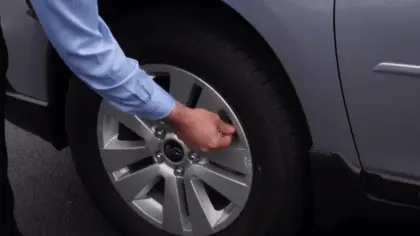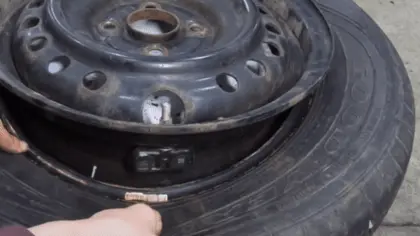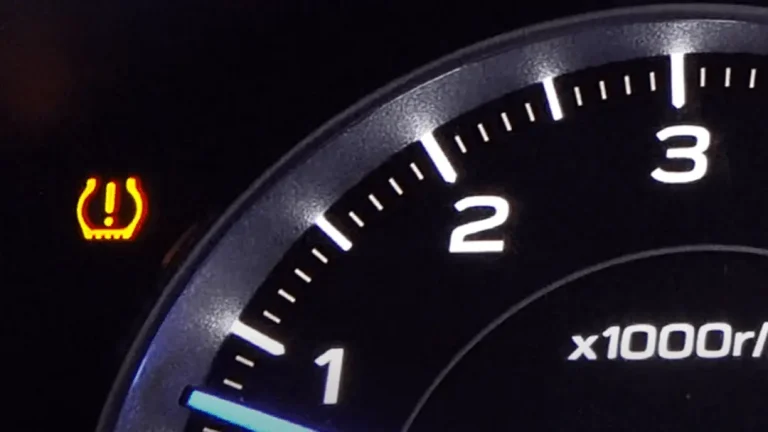The different Subaru models incorporate safety systems, as is the case with most vehicles. One of the typical problems is the Subaru tire pressure sensor problem.
It is a small sensor incorporated into the vehicle’s tires to provide excellent safety.
This problem is usually caused by different circumstances that we mention below. Tire pressure is one of the most critical aspects of driving safety.
So the following information will allow any driver to be aware of these circumstances.
6 Common Subaru Tire Pressure Sensor Problem & the Solutions

1. Air leakage in the tires
On certain occasions, we can find a metal collar in the systems that incorporate an integrated sensor.
This can be problematic as the functionality is different from the rubber valves, which are the primary and most common option.
Rubber valves usually seal the rim bore, which is not the case with a metal collar. These metal options require a rubber O-ring and torque for sealing.
So here, the chances of air leakage are higher.
2. Possible frequency inhibitors
In some regions of a city or elsewhere, there may be a magnetic field strong enough to inhibit the frequency of the sensors.
This is usually the most common reason, although other frequency inhibitors may also exist.
The most common problem is to be near a high-voltage pylon. When frequency jammers accumulate in the same geographical area, the sensors may not work for some time.
3. Possible control unit deprogramming
A deprogramming of the vehicle’s control unit may occur on certain special occasions. This can happen when replacing a battery or being left with a completely dead battery.
This situation also happens when a jump start is required. In this situation, the vehicle may lose the coding of the sensors of this system.
It is also necessary to consider that the programming of the control unit and these sensors is not easy to solve or for any beginner.
4. Possible false alarms
The vehicle control unit may encounter sufficient factors for a false alarm.
This is very common when only one part of the vehicle is in the shade while some of the wheels of the exact vehicle are exposed to the sun.
Possibly many drivers encounter this type of situation when they have parked on the street under a tree, and the vehicle spends many hours in this location.
A similar situation could occur with various weather conditions related to the road or the characteristics of the area in which the vehicle is parked.
5. Possible blows to the tire or rim
Some mechanics may not be careful enough when working on the rim or a tire. Sometimes old tires need to be removed.
Some bumps could produce small enough damage when tires or rims are removed to stop the TPMS system sensor from working.
Even this device which works on each of the wheels of the vehicle could be damaged by some shocks produced by the driver himself.
This is precisely what happens when the driver has hit the edges of a road with the side of the wheels.
In this situation, the sensors will start to give false alarms, or the control unit may indicate to the driver that something is wrong with the tires.
Taking this aspect into account can allow the driver to have a much more patient and responsible level of driving.
6. Problems with the sensor batteries
As we have mentioned, the sensors of this system are not usually connected to the vehicle’s electrical system in such a way that they require an additional source of energy that is not the same as the vehicle’s battery.
For this purpose, a tiny battery is usually incorporated, which provides a useful life of approximately 3 to 7 years.
One of the main drawbacks of this type of battery is that they are not replaceable. When the sensor batteries are entirely depleted, the driver is responsible for completely replacing the sensor.
Considering this aspect as one of the main ones saves a lot of work in an overly complex inspection of possible problems.
Best Solutions for the Subaru Tire Pressure Sensor Problems
Air leakage in the tires
An efficient and quick solution is to check the tightness of the metal collar valve from time to time.
It is also highly recommended to replace the O-ring with another high-quality part in case of leakage.
Possible frequency inhibitors
When a person encounters frequency inhibitor zones or factors, they should simply leave that zone.
The devices will be able to function again and correctly with the absence of all these frequency inhibitors.
Possible control unit deprogramming
The sensors could be unrecognizable to the control unit in the event of deprogramming.
In this situation-specific diagnostic equipment is necessary to reprogram the control unit according to the tire sensors.
Possible false alarms
In case of tire temperature difference, continue driving. After a few minutes of driving, the vehicle’s tires may equalize in temperature, making a false alarm disappear.
Possible blows to the tire or rim
The sensors of this system are usually somewhat vulnerable. So if there have been any damage blows to the tire sensors, this device should be replaced.
Otherwise, the driver will only get a permanent malfunction.
Problems with the sensor batteries: Like the previous solution, when the batteries of the tire sensors are shot, the driver needs to replace this small device.
At present, there is no possibility to replace only the batteries of these sensors.
Subaru Tire Pressure Sensor: How does It Work?
This system is related to the mechanisms that control tire pressure.
Many manufacturers incorporate this mechanism as one of the basic safety systems to protect drivers from inevitable traffic accidents. The system allows measuring the pressure level of each tire in real-time.
In different countries around the world, this system has become mandatory. This system is usually incorporated together with other safety devices such as stability control.
It is also often a system closely related to seat belts, airbags, or ABS brakes.
How does the Subaru pressure sensor work?
When this system is put into operation, the driver can know the specific condition of the wheels. When one of the tires does not have the proper pressure, the system can alert the driver.
One of the most basic functions is to notice an alert on the vehicle’s instrument panel.
People will have the possibility of noticing the letters TPMS in orange or simply a vehicle icon highlighting the tire area.
However, the essential systems do not allow for knowing exactly which of the tires has low pressure.
Of course, there are vehicles with more complete systems that provide much more accurate and efficient information. It is possible to check the pressure of each tire and the temperature of each tire.
Subaru TPMS Sensor

As we have mentioned, this tire pressure monitoring system is an essential part of the safety systems of many vehicles.
We can find this system an essential part of the entire safety system of a wide variety of modern vehicles.
That is why knowing the two main methods in which these device works allows drivers to be alert about tire pressure.
Indirect measurement: On many occasions, drivers need to turn the wheels a more significant number of times to travel the same distance when one of the tires has the wrong pressure.
This means that we may find a tire with a smaller diameter due to the low-pressure level. The TPMS system can work with the ABS sensors to find out exactly which tire has lost pressure.
This is done by detecting one or more wheels spinning a more significant number of times than usual.
Direct measurement: Many experts claim that it is a more efficient safety system when it comes to this type of measurement.
In each tire, there is a pressure sensor that can directly measure this factor in the tires. There are also different types of sensors, but the most common are those attached to the tire valve.
Devices are also usually incorporated on the inside of the tread because these sensors are glued exactly to the rubber of each tire.
These sensors are responsible for measuring the temperature and pressure in either tire. A 433 megahertz frequency is also used via radio to provide information to the control unit.
The latter system, in particular, is usually more efficient, as it is the TPMS system that provides a higher level of efficient information.
When a system with indirect measurement is too basic, the driver may not be sure which tires are problematic.
Important FAQs about Subaru Tire Pressure Sensor Problems & Solutions
1. How to reset the TPMP of a Subaru model?
First of all, it is essential to consider the exact moment when the light of this system comes on. Many vehicles usually incorporate a reset button related to this safety system.
The driver must press this reset button. The TPMS light will start flashing three times at a certain point, and then the driver should release the button.
It is also essential to start the vehicle and let it idle for more than 20 minutes. This will allow the driver to reset the sensor completely.
Under the driver’s steering wheel, there is usually a reset button for this system. It is also possible to check the owner’s manual if you cannot find the TPMS reset button.
2. How to check for TPMS sensor damage?
It is possible to check the possible damage to these sensors located in the vehicle’s tires. The system is updated from time to time by checking the current tire pressure levels.
So it is beneficial to drive for a few minutes to check if the light of this system goes out.
In case this light stays on, it is necessary to check the problems and solutions mentioned above. In severe cases, it is necessary to consult an expert mechanic to diagnose the vehicle.
The problem may be a faulty sensor or tires with low pressure, which is more dangerous.
3. What if the tires are undamaged and the TPMS light is on?
Occasionally the TPMS light may come on for no apparent reason. This light should come on when tire pressure drops below 25% or more in a typical operation.
However, this could be a false alarm, so it is not necessary to inflate the tires immediately.
If this is what the driver does, the tire pressure could be too high. This happens when the driver does not detect that it is a false alarm and decides to increase the tires’ air pressure anyway.
4. What can happen when a TPMS sensor fails?
When a TPMS sensor starts to fail, the possibility of a false alarm can increase considerably. The opposite situation could also occur.
The control unit may fail to detect air loss or pressure drop in some tires in these cases.
To avoid these inconveniences, it is recommended to replace the battery approximately every 3 to 5 years. It is also necessary to avoid possible blows to the tires since this could damage the sensors.
5. Where in the vehicle is the TPMS and reset button located?
This system is usually located in the control unit and works together with the tire sensors.
Sometimes the driver needs to use the reset button, but it is not permanently installed in the same place. It is possible to find the reset button for this system under the steering wheel in most vehicles.
If the reset button is not found in this place, the driver can consult the owner’s manual. In this way, it will be possible to use the reset button to have excellent functioning of the TPMS system.
6. What budget is needed for a TPMS sensor?
Some drivers want to find the best way to fix the sensor of this safety system. However, it is a part that is easily damaged and needs to be replaced.
In the vast majority of situations, the driver needs to budget between $230 and $750.
In this case, most of the cost is related to the sensor specifically and not the labor. Considering only these small devices alone will require a budget of $180 and up to $680 in some cases.
7. What happens when the TPMS is not working?
There are different reasons to take into consideration when this system is not working. One of the most common reasons is when there is some kind of failure with the electrical system.
The control unit could suffer deprogramming. This causes the sensors located in each of the tires to not be recognized by the control unit.
Most of the time programming problems occur when the vehicle’s battery has died or is about to die.
Another of the most common reasons is a typical failure of some parts of the electrical system. The other reason to take into consideration while driving is the shocks that may occur in the tires or rims.
Some bumps can be more than enough to damage the vulnerable TPMS sensor. This can lead to the malfunctioning of the entire TPMS system and various false alarms.
8. What happens when the TPMS lights do not come on?
When a vehicle’s tires have sufficient air pressure, it means that the TPMS lights should not come on.
However, there are some situations in which the air pressure has dropped by 25% in some tires. In this type of situation, the tire pressure warning lights should come on and alert the driver.
Most likely in this specific situation, the control unit that works with the sensors in the tires has a problem.
If, on the other hand, these lights stay on and do not turn off, there could be a leak in the tires. It is highly recommended to have a tire tool or tire gauge to check the air pressure and detect possible leaks.
9. Can anyone reprogram the TPMS?
It is not recommended that anyone program the TPMS sensors or control unit.
Good results can only be obtained when the person performing this task has specific mechanical or technical knowledge. This may mean the need for a diagnostic machine or knowledge of the appropriate software.
In case of not have the appropriate knowledge for this task, it is not advisable to perform this procedure. This is because the sensors have specific programming.
In addition, making any kind of error can cause a wide variety of imbalances in the control unit or even in the ECU.
On the contrary, having an expert mechanic can be the best way to solve this problem and prevent other possible malfunctions of the vehicle.
For experienced mechanics, programming a TPMS is not a complicated task.
Final Verdict
Constantly checking any Subaru tire pressure sensor problem can allow a driver to enjoy a higher level of safety at all times.
The most important thing, in this case, is to avoid curbing or bumping and to be on the lookout for possible air leaks.
It is also recommended to replace the sensor from time to time or to have a diagnostic kit for more technical problems.

